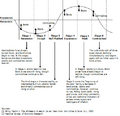Business Cycle: An Idealized Diagram
The theory of the business cycle sets the stage for a topical analysis of the stock, bond and commodity markets. Depending on sequential GDP growth rates and other considerations, the economy is said to be either in a state of expansion (i.e., cycling above the horizontal, or equilibrium, line in the figure below) or contraction (cycling below it). The arrows indicate when each market normally begins to move, and in which direction. Since the end of WWII, there have been eleven complete cycles. The average contraction has lasted ten months, and the average expansion, 59 months.

(Click to enlarge)
The horizontal line in the exhibit at left represents the economy’s equilibrium level. Above the line, economic growth is positive; the economy is in an expansion mode. Below the line, growth is negative and (depending on the severity of the downturn) the economy may be either contracting or in an actual recession. The phases depicted at left may be termed, respectively: the late contraction or recession phase (Stage One), trough, bull market (Stage Three), late expansion, peak (at Stage Five) and early contraction. In the section on stocks, we will analyze sector rotation strategies in the context of the business cycle.
(Click here for other business-cycle diagrams: at QuickMBA.com; at Investopedia.)
The most important takeaway from the exhibit is that the end of an intermarket bull run (i.e., a period during which stocks, bonds and commodities are all rising together) may first be signaled by a downturn in bond prices. This follows an extended period of corporate pricing power, during which firms are able to charge high prices in a high-demand environment. Higher inflation, though tolerated at first, leads to higher interest rates, as the Fed uses monetary policy to try to curtail inflation. By raising the cost of credit, the Fed hopes (i) to limit borrowing by businesses and consumers and (ii) incentivize greater savings. Higher interest rates reduce the cash-flow potential represented by equity ownership, eventually leading to softer stock prices (Stage 5). Finally, inflation catches up with commodities——which are typically the last to succumb, being furthest removed from the end-user economy in which corporate pricing power had started running rampant. According to Murphy [1991], the deterioration in commodity prices may itself be initially signaled by a downturn in gold prices. In the section on commodities, we examine this issue further.
Of course, actual business cycles often differ markedly from the idealized abstraction pre-sented above. Still, it should be possible to identify the current phase of the cycle on an almost constant basis using certain macroeconomic and market indicators, which we discuss, and thereby to determine which areas of the economy may be expected to out- or underperform.
The intensity of the cycle is of particular importance in forming a sector rotation strategy. That is, the strength (or weakness) of the various indicators that support a given cyclical outlook must be considered in the decision-making process. A high (low) level of confidence in the macroeconomic thesis should equate to an aggressive (conservative) move from the presiding asset allocation strategy, and extremely low confidence may actually propel a more conservative strategy altogether. This is one of the assumptions built into the Stracia framework. At the tactical level, macroeconomic events that can support or thwart the dominant cyclical trend—but which are not represented in the Stracia frame-work—may be placed into several categories: systemic changes to the tax code or national healthcare or legal systems (e.g., tort reform), industry-specific regulatory trends, etc.
For portfolios pursuing absolute return strategies, the importance of combining cyclical and sector research is felt most deeply during major turning points in the market—i.e., the beginning of Stages 2 and 5. During these periods, correlations among asset classes are typically increasing, so that most categories tend to perform similar to one another.
For portfolios pursuing relative return strategies, this combined cyclical/sector approach is most important when the market is trending—that is, from Stages 2 through 5 or Stages 6 through 1 (the start of a new cycle). These periods are marked by significant differences in the performance of various asset categories (low correlations among classes).
« Previous: Stracia’s Macro Approach | Next: Typical Cyclical Profile»
Your suggestions for improving this site are greatly appreciated. (To report an error on this page, please copy the URL before visiting the suggestion box.)



